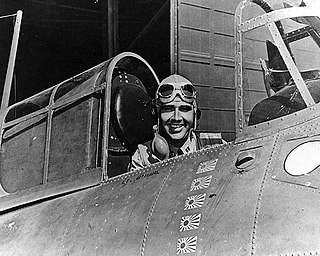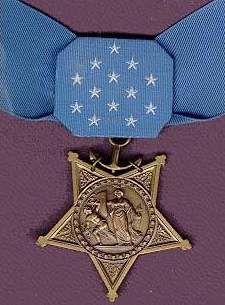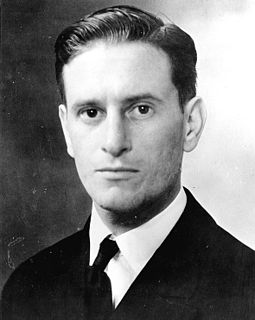
The Battle of the Coral Sea, from 4 to 8 May 1942, was a major naval battle between the Imperial Japanese Navy (IJN) and naval and air forces of the United States and Australia. Taking place in the Pacific Theatre of World War II, the battle is historically significant as the first action in which aircraft carriers engaged each other and the first in which the opposing ships neither sighted nor fired directly upon one another.

Zuikaku was a Shōkaku-class aircraft carrier of the Imperial Japanese Navy. Her complement of aircraft took part in the attack on Pearl Harbor that formally brought the United States into the Pacific War, and she fought in several of the most important naval battles of the war, before being sunk during the Battle of Leyte Gulf.

Lieutenant Commander Edward Henry O'Hare was an American naval aviator of the United States Navy, who on February 20, 1942, became the Navy's first flying ace when he single-handedly attacked a formation of nine heavy bombers approaching his aircraft carrier. Even though he had a limited amount of ammunition, he was credited with shooting down five of the enemy bombers and became the first naval recipient of the Medal of Honor in World War II.

USS Yorktown (CV-5) was an aircraft carrier commissioned in the United States Navy from 1937. Named after the Battle of Yorktown in 1781, she was the lead ship of the Yorktown class, which was designed on the basis of lessons learned from operations with the converted battlecruisers of the Lexington class and the smaller purpose-built USS Ranger.

USS Enterprise (CV-6) was a Yorktown-class carrier built for the United States Navy during the 1930s. She was the seventh U.S. Navy vessel of that name. Colloquially called "The Big E", she was the sixth aircraft carrier of the United States Navy. Launched in 1936, she was one of only three American carriers commissioned before World War II to survive the war. She participated in more major actions of the war against Japan than any other United States ship. These actions included the attack on Pearl Harbor — 18 Douglas SBD Dauntless dive bombers of her Air Group arrived over the harbor during the attack; seven were shot down with eight airmen killed and two wounded, making her the only American aircraft carrier with men at Pearl Harbor during the attack and the first to sustain casualties during the Pacific War — the Battle of Midway, the Battle of the Eastern Solomons, the Battle of the Santa Cruz Islands, various other air-sea engagements during the Guadalcanal Campaign, the Battle of the Philippine Sea, and the Battle of Leyte Gulf. Enterprise earned 20 battle stars, the most for any U.S. warship in World War II, and was the most decorated U.S. ship of World War II. She was also the first American ship to sink a full-sized enemy warship after the Pacific War had been declared when her aircraft sank the Japanese submarine I-70 on 10 December 1941. On three occasions during the war, the Japanese announced that she had been sunk in battle, inspiring her nickname "The Grey Ghost". By the end of the war, her planes and guns had downed 911 enemy planes, sunk 71 ships, and damaged or destroyed 192 more.
Samuel Jackson Underhill was a naval aviator of the United States Navy who was killed in action during the Battle of the Coral Sea.

The Yorktown class was a class of three aircraft carriers built for the United States Navy and completed shortly before World War II, the Yorktown (CV-5), Enterprise (CV-6), and Hornet (CV-8). They immediately followed Ranger, the first U.S. aircraft carrier built as such, and benefited in design from experience with Ranger and the earlier Lexington class, which were conversions into carriers of two battlecruisers that were to be scrapped to comply with the Washington Naval Treaty, an arms limitation accord.

The Battle of the Santa Cruz Islands, fought during 25–27 October 1942, sometimes referred to as the Battle of Santa Cruz or Third Battle of Solomon Sea, in Japan as the Battle of the South Pacific, was the fourth aircraft carrier battle of the Pacific campaign of World War II. It was also the fourth major naval engagement fought between the United States Navy and the Imperial Japanese Navy during the lengthy and strategically important Guadalcanal campaign. As in the battles of the Coral Sea, Midway, and the Eastern Solomons, the ships of the two adversaries were rarely in sight or gun range of each other. Instead, almost all attacks by both sides were mounted by carrier- or land-based aircraft.

The Douglas SBD Dauntless is a World War II American naval scout plane and dive bomber that was manufactured by Douglas Aircraft from 1940 through 1944. The SBD was the United States Navy's main carrier-based scout/dive bomber from mid-1940 through mid-1944. The SBD was also flown by the United States Marine Corps, both from land air bases and aircraft carriers. The SBD is best remembered as the bomber that delivered the fatal blows to the Japanese carriers at the Battle of Midway in June 1942. The type earned its nickname "Slow But Deadly" during this period.

Bruce Avery Van Voorhis was a United States Navy aviator who was shot down in the Pacific theater during World War II. For his action on July 6, 1943, he was posthumously awarded the Medal of Honor.

Eugene E. Lindsey was an officer and aviator in the United States Navy. He is the namesake of the destroyer USS Lindsey (DD-771).
William Bowen Ault was a commander in the United States Navy during World War II and a posthumous recipient of the Navy Cross.
John Drayton Baker was an American Naval aviator who was awarded the Navy Cross for his actions during World War II.
Leonard W. Thornhill, born on August 17, 1915, in Lamison, Alabama, was appointed to the U.S. Naval Academy on June 19, 1934, graduated on June 2, 1938, and was commissioned an ensign.

Richard Halsey Best was a dive bomber pilot and squadron commander in the United States Navy during World War II. Stationed on the aircraft carrier USS Enterprise, Best led his dive bomber squadron at the 1942 Battle of Midway, sinking two Japanese aircraft carriers in one day, before being medically retired that same year due to damage to his lungs caused by breathing bad oxygen during the battle.
Edward B. Kinzer (1917–1942) was a United States Navy officer who received the Navy Cross posthumously for his actions in combat during World War II.
Walter Schindler was a highly decorated career officer in the United States Navy, who ultimately achieved the rank of Vice Admiral. While a Commander during World War II, Schindler received a Navy Cross and a Silver Star for his service aboard the Yorktown (CV-5), including during the Battle of the Coral Sea. He was later twice awarded the Legion of Merit.

VA-54 was an early and long-lived Attack Squadron of the U.S. Navy, operating under many designations during its 20-year life. It was established as Scouting Squadron VS-2B on 3 July 1928, and redesignated as VS-3 on 1 July 1937, and as Bombing Squadron VB-4 on 1 March 1943. It was redesignated as VB-5 on 15 July of that same year, and as Attack Squadron VA-5A on 15 November 1946. Finally, it was redesignated as VA-54 on 15 November 1946. VA-54 was disestablished on 1 December 1949. The squadron's insignia varied over its lifetime, depicting in turn a bird dog, a devil, and finally a bomb and five playing cards. Its nickname is unknown. It was the first squadron to be designated VA-54, a second VA-54 was redesignated from VF-54 on 15 June 1956 and disestablished on 1 April 1958.
The Enterprise Air Group was established on 1 July 1938, encompassing all squadrons embarked in USS Enterprise (CV-6). The group was divided into four squadrons, each with eighteen aircraft dedicated to a particular role. The squadrons were designated according to their role, and all were given the unit number six, derived from the hull number of the Enterprise. Bombing Six (VB-6) was equipped with Douglas SBD-2 Dauntless dive bombers, Fighting Six (VF-6) with Grumman F4F-3 Wildcat fighters, and Torpedo Six (VT-6) with Douglas TBD Devastator torpedo bombers. The fourth squadron, Scouting Six (VS-6) also had the SBD-2 Dauntless, but was more focused on the scout bomber role. This air group was embarked on board the Yorktown-class aircraft carrier USS Enterprise (CV-6) at the time of the attack on Pearl Harbor.

The Battle of the Santa Cruz Islands was fought 25–27 October 1942 in the waters northwest of the Santa Cruz Islands by forces of the Imperial Japanese Navy's (IJN) Combined Fleet and the United States Navy's (USN) Pacific Fleet. The battle resulted from a major Japanese offensive with the goal to drive the US forces from Guadalcanal.












